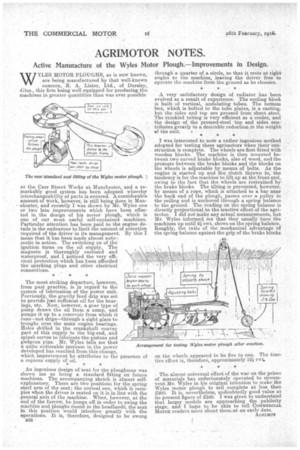AGRIMOTOR NOTES.
Page 16

If you've noticed an error in this article please click here to report it so we can fix it.
Active Manutacture of the Wyles Motor Plough.—Improvements in Design.
WYLES MOTOR PLOUGHS, as is now known, are being manufactured by that well-known , concern, R. A. Lister, Ltd., of Dursley, .Glos., this firm being well equipped for producing the machines in greater quantities than was ever possible
at the Carr Street Works at Manchester, and a remarkably good system has been adopted whereby interchangeability of pazts is ensured. A considerable amount of work, however, is still being done in Manchester, and receetly I was shown by Mr. Wyles one or two late improvements which have been effected in the design of his motor plough, which is one of our most useful self-contained machines. Particular attention has been paid to the engine details in the endeavour to limit the amount of attention required of the driver in its management. By this I mean that it has been made almost automatic in action. The switching on of the ignition turns on the oil supply, The magneto is thoroughly enclosed and waterproof, and I noticed the very efficient protection which has been afforded the sparking plugs and other electrical connections.
The most striking departure, however, from past practiae, is in regard to the system of lubrication of the power unit. Previously, the gravity feed drip was set to provide just sufficient oil for the bearings, etc. Now, however, a gear type of pump draws the oil from a sump, and pumps it up to a reservoir from which it runs—not drips—through a sight glass to troughs over the main engine bearings. Holes drilled in the crankshaft convey part of this supply to the big-end, and splash serves to lubricate the pistons and gudgeon pins. Mr. Wyles tells me that a quite noticeable increase in the power developed has resulted from this change, which improvement he attributes to the a copious supply of oil.
An ingenious design of 'seat for the ploughman was shown me as being a standard fitting on future machines. The accompanying sketch is almost selfexplanatory. There are two positions for the spring steel arm, of the seat: the normal one, which it occupies when the driver is seated on it is in line with the general axis of the machine. When, however, at the end of the furrow, he jumps off. in order to swing the machine and ploughs round in the headlands, the seat in this position would interfere greatly with the operations. It is, therefore, designed to be swung
3338 . through a quarter of a circle, so that it rests at right angles to the machine, leaving the driver free to operate the machine from the ground as he chooses.
A very satisfactory design of radiator has been evolved as a result of experience. The cooling block is built of vertical, undulating tubes. The bottom box, which is bolted to the tube plates, is a casting, but the sides and top are pressed from sheet steel. The crinkled tubing is very efficient as a cooler, and the design of the pressed-steel top and sides contributes greatly to a desirable reduction in the weight of the unit. • • • I was interested to note a rather ingenious method adopted for testing these agrimotors when their construction is complete. The wheels are first fitted with wooden blocks. The machine it then Mounted between two curved brake blocks., also: of wood, and the pressure between the brake blocks and the blocks on the wheels is adjustable by means of bolts. As the engine is started up and the clutch thrown in the tendency is for the machine to lift up at the froneend, owing to the fa,et that the wheels are restrained by the brake blocks. The tilting is prevented, however, by means of a rope, which is attached to a bar near the back end of the plough, passes over a pulley in the ceiling and is anchored through a spring balance to the ground. The reading on the spring balance is directly proportional to the tractive effort of the agrimotor. I did not Make any actual measurements, but Mr. Wyles informed, Me that they usually time the machines up until 2i cwt. shows on the spring balance. Roughly, the ratio ef the mechanical advantage of the spring balance against the grip of the brake blocks on the wheels appeared to be five to one. The:tractive effort is, therefore, approximately 1.2-i ewt.
The almost universal effect of the war on the prices of materials has unfortunely operated to circumvent Mr. Wyles in his original intention to make the Wyles motor plough to sell complete at less than .R:200. It is, nevertheless, undoubtedly good value at its present figure of £240. I was given to understand that larger models are approaching the publicity • stage, and I hope. to 'be able to tell COMMERCIAL MOTOR readers more about thern.at an early date. ACR1MOT






















